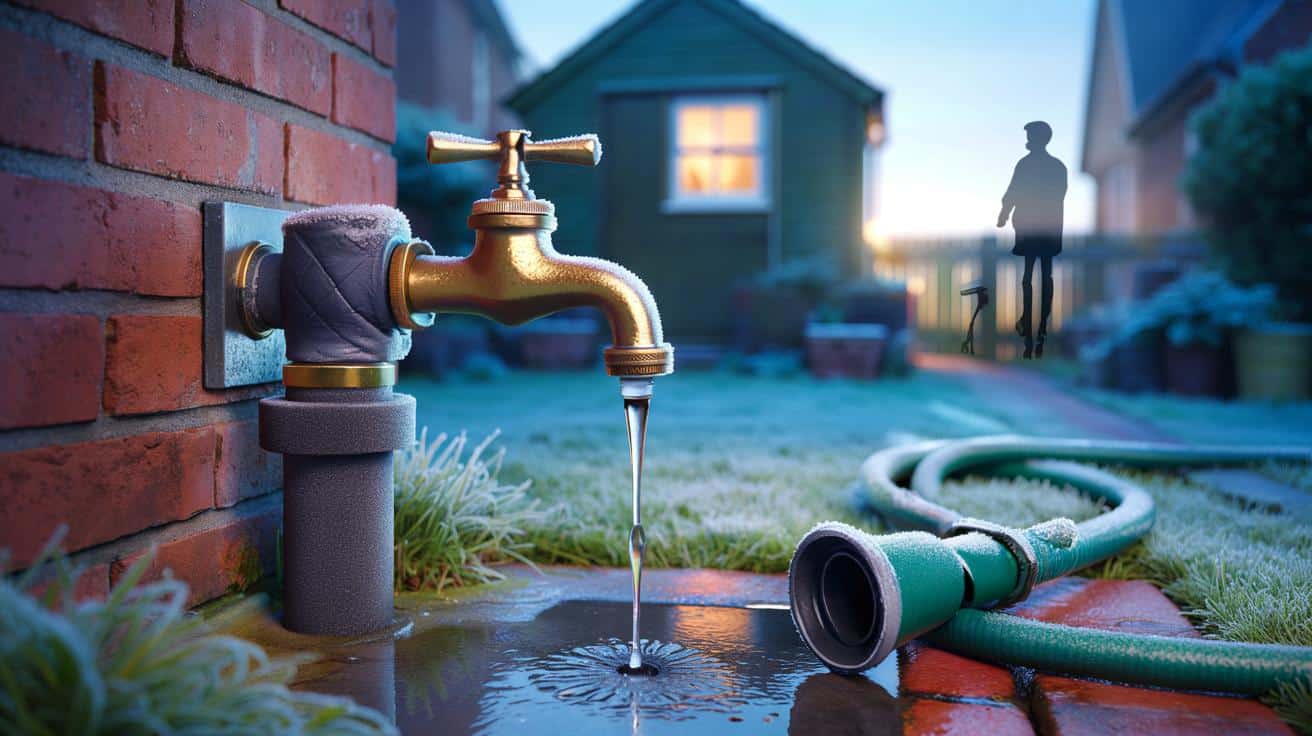First frosts don’t just crisp the lawn; they quietly load your pipework like a spring. An outside tap can freeze solid before dawn, then thaw by lunchtime and burst when you’re at work. The fix is simpler than most people think — and it takes minutes, not money.
12am on a brittle November morning, the garden looks like it’s been dusted with sugar. The dog skids, the shed door sticks, and the outside tap is white with rime, a tiny crown of ice sitting where a hose was left last weekend. Across the fence, a neighbour is mopping in slippers, muttering about a “split pipe” and the smell of damp cardboard. You feel that little jolt of recognition: the tap you use for washing the car in July becomes a time bomb in cold snaps. We call it bad luck. It isn’t. One tiny twist changes everything.
Why garden taps freeze — and the domino effect
Outside taps are usually fed by a short run of pipe that lives in the coldest bit of your home — a garage wall, a ventilated cavity, a north-facing brick. The metal body of the tap conducts the chill, the standing water inside slows to a slush, then locks. That’s when pressure starts to climb, invisibly and quietly. The pipe won’t always split at the tap either. It often fails in the weaker, thinner bit you can’t see.
Ask around and you’ll hear the same story. A hose left attached forms a neat little ice plug, trapping water in the line, and the first proper frost does the rest. In Leeds last year, a family came home to a ceiling bowed like a drumskin and a carpet that squelched — the culprit was a frozen outside feed that let go during a thaw. The bill ran into thousands, the stress even higher. One small oversight, huge consequences.
Here’s the odd physics bit: water expands as it freezes, but the fatal blow often lands when it thaws. Ice masks the leak point; then, as liquid returns and pressure resumes, a hairline crack becomes a jet. That’s why the damage often appears late morning, not at dawn. Taps with worn washers, uninsulated pipe runs, and missing isolator valves make the risk worse. The good news is the solution is boringly simple, which is exactly what you want in November.
The 10‑minute method to winter‑proof your outside tap
Start inside. Find the small isolator valve feeding your outside tap — usually a little slotted or lever valve on the cold line under your kitchen sink or near the back wall. Turn it off. Now go outside and open the garden tap fully. If there’s a drain cock by the inside valve, open that too to let water dribble out. Wait until the flow stops, close the drain cock, and leave the outside tap open a quarter turn. It feels almost too easy.
Next, unscrew and store the hose. Wrap the exposed pipe and the tap body with self-seal foam lagging, then slip on a tap cover (the £6 kind with a drawstring works a treat). If you’ve got a long external run, add foam sleeves and tape the joints so there are no gaps. For a shed or garage tap that always freezes, consider a low-wattage, thermostat trace-heating cable under the insulation. Let’s be honest: nobody really does that every day. So do the lot once, properly, and forget it.
We’ve all had that moment when a forecast says “-3°C” and you think, I’ll sort it tomorrow. The truth: ten minutes tonight beats ten days of drying out. Ten minutes now beats a £3,000 leak later.
“Pipes don’t always burst when they freeze — they burst when they thaw,” says Tom, a South London plumber. “Isolate, drain, wrap. It’s that simple.”
- What to buy: tap cover (£5–£10), 15mm self-seal foam lagging (£2–£3 per metre)
- Nice-to-haves: cable ties or tape, small flathead screwdriver, PTFE tape for drips
- Worth checking: your stopcock turns easily; the isolator has a working drain point
- For outbuildings: a plug-in trace-heat cable with built‑in thermostat
Stay winter‑ready this November
Cold snaps don’t book an appointment. They roll in on a Tuesday night and leave you paddling by Wednesday lunch. The easiest habit is a once-and-done winterising: isolate the outside feed, drain it, and give the tap a cheap jacket. Keep hoses off, gaps sealed, and vulnerable runs wrapped. If your home sits empty for a few days, set the heating to a low, steady 12–15°C and open kitchen and bathroom cabinets so air circulates. Dripping a tap is a last resort and wastes water, but for a single gnarly night on an exposed run, a slow trickle can keep things moving. If it’s already frozen, turn off the stopcock, open the nearest cold tap, and warm the pipe gently with a hairdryer on low or warm towels — no flames, no boiling water. Call a pro if you spot bulges, cracks, or a mystery drip. Small rituals prevent big messes.
| Key points | Detail | Reader Interest |
|---|---|---|
| Isolate and drain | Shut the indoor valve, open the garden tap, use the drain cock, leave tap slightly open | Prevents pressure build-up and burst risk in minutes |
| Remove and store hoses | Hose left on creates an ice plug that traps water in the line | Stops the most common cause of split pipes |
| Insulate and cover | Foam lagging on exposed pipe, tap cover on the body, tape the gaps | Cheap kit, instant protection during frosts |
FAQ :
- How do I find my outside tap’s isolator valve?Look under the kitchen sink or along the back wall for a small slotted or lever valve on the cold feed. Follow the pipe that heads outside.
- Should I leave the outside tap dripping overnight?Only as a last resort on an exposed run. The better fix is to isolate, drain, and insulate so there’s nothing left to freeze.
- Are tap covers alone enough?They help a lot, but covers work best with foam lagging on any exposed pipe and with the line drained down.
- At what temperature do pipes freeze?Risk climbs near 0°C, especially in wind. Uninsulated, shallow runs can freeze quickly during clear, still nights.
- What if my pipe is already frozen or has burst?Turn off the stopcock immediately. Open the nearest cold tap, warm the pipe gently, and call a qualified plumber if you see cracks or leaking.








